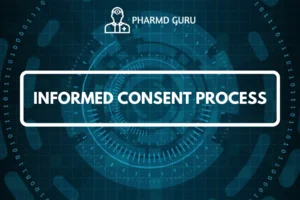SAFETY MONITORING IN CLINICAL TRIALS:
Safety monitoring is a critical aspect of conducting clinical trials to ensure the well-being of participants and maintain the integrity of research data. It involves the collective responsibilities of various stakeholders, including investigators, Institutional Review Boards/Independent Ethics Committees (IRB/IEC), sponsors, monitors, and Data and Safety Monitoring Boards (DSMB). In this article, we will explore the roles and responsibilities of each stakeholder in safety monitoring and discuss its significance in different phases of clinical trials.
SCROLL DOWN TO THE BOTTOM OF THE PAGE FOR ACTUAL NOTES
Introduction to Safety Monitoring:
Safety monitoring is a systematic process that involves ongoing surveillance and assessment of participant safety throughout the duration of a clinical trial. Its primary objective is to identify and minimize any potential risks or adverse events associated with the investigational product or study procedures, ensuring the highest level of participant protection.
Investigator’s Responsibility in Safety Monitoring:
Investigators play a crucial role in safety monitoring. They are responsible for conducting the trial according to the approved protocol, ensuring participant safety, and promptly reporting any adverse events or serious adverse events that occur during the trial. Investigators also collaborate closely with the IRB/IEC to address safety concerns and make informed decisions regarding the study.
IRB/IEC Responsibility in Safety Monitoring:
IRBs/IECs are independent committees responsible for reviewing and approving clinical trial protocols to safeguard the rights and welfare of participants. In safety monitoring, IRBs/IECs evaluate the potential risks associated with the study and provide ongoing oversight throughout the trial. They review safety data, assess participant protections, and ensure compliance with ethical guidelines and regulatory requirements.
Sponsor’s Responsibility in Safety Monitoring:
Sponsors hold the ultimate responsibility for safety monitoring in clinical trials. They oversee the entire trial process and provide the necessary resources and support to ensure participant safety. Sponsors are responsible for developing a robust safety monitoring plan, implementing risk mitigation strategies, and promptly reporting safety-related information to regulatory authorities. They collaborate closely with investigators and monitors to ensure compliance with Good Clinical Practice (GCP) guidelines.
Monitor’s Responsibility in Safety Monitoring:
Monitors are appointed by the sponsor to oversee the conduct of the clinical trial at various investigative sites. They play a crucial role in safety monitoring by conducting site visits, reviewing study documentation, and ensuring compliance with the study protocol and regulatory requirements. Monitors assess the quality and integrity of safety data, identify any protocol deviations or non-compliance issues, and provide guidance to investigators for corrective actions.
Safety Monitoring in Different Phases of Clinical Trials:
Safety monitoring practices may vary across different phases of clinical trials. In early-phase trials, safety monitoring primarily focuses on assessing the tolerability and potential risks associated with the investigational product in a small group of participants. As trials progress to later phases, safety monitoring expands to include a larger participant population and long-term safety assessments. The focus shifts towards evaluating the overall safety profile, potential drug interactions, and any rare or long-term adverse events.
Data and Safety Monitoring Board (DSMB):
A Data and Safety Monitoring Board (DSMB), also known as a Data Monitoring Committee (DMC), is an independent group of experts that provides additional oversight in safety monitoring. DSMBs review safety and efficacy data during the course of a clinical trial and make recommendations regarding the continuation, modification, or early termination of the trial based on their analysis. Their objective assessment ensures participant safety and maintains data integrity.
Interim Monitoring:
Interim monitoring involves the periodic analysis of safety data at pre-defined time points during a clinical trial. This analysis allows for the evaluation of safety trends, identification of potential safety concerns, and adjustment of the trial’s conduct if necessary. Interim monitoring provides an opportunity to ensure participant safety and make informed decisions regarding the trial’s progression.
Early Studies and Other Responsibilities:
In the early stages of clinical development, safety monitoring plays a crucial role in identifying the potential risks associated with the investigational product. This early-phase safety monitoring helps inform subsequent study designs and ensures participant safety in future trials. Additionally, other responsibilities in safety monitoring include the collection, analysis, and reporting of safety data to regulatory authorities, as well as the ongoing training of trial personnel to maintain high standards of safety and compliance.
ACTUAL NOTES




